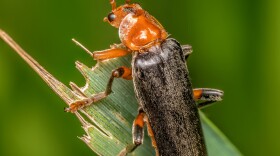You may have heard us use the term “sit and wait” predator many times before. What we’re referring to are typically animals that hide or blend into their environment and then patiently wait for their next meal to move into striking range. But when it comes to remaining out of sight while waiting for prey, there are a few groups of spiders that have perfected the art of sit and wait hunting. They’re called trapdoor spiders. Rather than using a web to capture prey, trapdoor spiders simply pounce on their victims, much in the same way that a jumping spider or tarantula will capture its next meal. In fact, trapdoor spiders are closely related to tarantulas and appear very similar, but are smaller, less hairy, and have shiny legs. What sets them apart from other sit and wait predators is where they do their waiting. Trapdoor spiders build tube-like tunnels into the ground. In order to hide the opening of their home, they construct a lid (hinged on one side) that’s made of spider silk mixed in with the soil and vegetation surrounding the burrow, creating a perfectly camouflaged cover. To detect potential prey, the spider lays down silk trip lines in front of the tunnel’s opening. When a insect, other arthropod, or small vertebrate disturbs the trip lines, in the blink of an eye the spider will leap out, capture its prey, and drag it back into the burrow where it can safely eat its meal. Sort of like a jack in the box, suddenly bursting out of its box, but in this case, it’s a hungry jack in the box, with fangs and venom.
Trapdoor Spider





